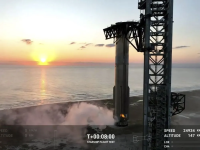Webb telescope detects what looks like a giant question mark in space
Author of the article:Washington Post
Washington Post
Joel Achenbach
Published Sep 05, 2024 • 3 minute read
The "Question Mark Pair" are a dusty red galaxy and a white spiral galaxy beside it. A third galaxy forms the punctuation mark's dot.
The "Question Mark Pair" are a dusty red galaxy and a white spiral galaxy beside it. A third galaxy forms the punctuation mark's dot. Photo by Space Telescope Science Institute /Washington Post
Astronomers have a lot of questions about the universe, and the universe, in turn, seems to have a question for astronomers. Or at least it has a question mark.
The “Question Mark Pair” is what astronomers have been calling the galaxies they’ve observed in deep space with the James Webb Space Telescope. It is really just an optical illusion. The intriguing image released Wednesday is the latest reminder that, when you study the universe with the Webb, funny things are everywhere.
The looping arc of the question mark is created by a pair of galaxies that, through the space-bending process of gravitational lensing, appears to be in multiple places simultaneously. One of the two galaxies — red and dusty — is the star of the show, because it pops up in five spots in the image.
Stretched, distorted and smeared by the torque of gravity, the red galaxy forms the top of the question mark. Just off to the side is a white spiral galaxy.
A third galaxy, by chance in the right spot as seen from the Webb’s position, forms the dot of the question mark.
Gravitational lensing is a handy tool for interrogation of the universe. It’s very much like using a magnifying glass, except what’s curved is not a piece of glass but space itself. According to Albert Einstein’s general theory of relativity, space and time (“spacetime”) are curved in the presence of massive structures, such as a cluster of galaxies. The new image is a compelling demonstration that the theory Einstein produced in 1915 accurately describes the fabric of the universe.
In this case, the lensing is caused by a galaxy cluster named MACS-J0417.5. According to the new report, this type of lensing is rare, and known among scientists as a “hyperbolic umbilic.”
The two galaxies are 7 billion light-years away and are so close together they are interacting, according to a news release from the Space Telescope Science Institute. Neither galaxy appears to have been distorted by the gravity of the other, and so astronomers believe they are seeing that interaction as it is just starting. Or, to be exact, as it was just starting 7 billion years ago.
This particular cluster of galaxies and the gravitational lensing produced by it had been studied before with the Hubble Space Telescope. But the Webb, a $10 billion observatory launched in 2021 and currently orbiting the sun about a million miles from Earth, has the ability to see deeper into the infrared portion of the spectrum than the Hubble.
The Hubble had seen the white spiral galaxy in the Question Mark Pair. But lurking next to it, undetected by the Hubble, was the second, dusty red galaxy.
A spiral galaxy is essentially a disk, like a Frisbee or a fried egg. Its appearance in our telescopes therefore depends on its orientation. The white spiral galaxy shows its broad, beautiful face, and looks like a pinwheel. The second, red galaxy shows only its edge, and is shaped more like a noodle.
The Hubble could not capture the second galaxy because dust blocks light more intensely from the view facing its edge. The Webb, however, can observe in wavelengths that penetrate dust.
“Wow, that’s amazing that dusty red galaxy pops out with [Webb] when it was totally invisible in our Hubble images!” Dan Coe, an astronomer at the Space Telescope Science Institute who is not part of the new research, said in an email. “That big clumpy galaxy appeared to be all alone with Hubble, but then [Webb] reveals another galaxy right on top of it.”
Everyone on the team was stunned when the Webb data was processed and turned into colour images, said astronomer Vicente Estrada-Carpenter, lead author of a scientific paper on the galaxy pair from researchers at Saint Mary’s University in Halifax, Nova Scotia.
“We instantly all saw the question mark,” he said. “It’s just a beautiful image.”
In an email, Heidi Hammel, vice president for science at the Association of Universities for Research in Astronomy, said of the new research, “So much of the distant universe is mysterious to us, and it is fun when the cosmos itself teases us with a cosmic question mark.”


 torontosun.com
torontosun.com
Author of the article:Washington Post
Washington Post
Joel Achenbach
Published Sep 05, 2024 • 3 minute read
The "Question Mark Pair" are a dusty red galaxy and a white spiral galaxy beside it. A third galaxy forms the punctuation mark's dot.
The "Question Mark Pair" are a dusty red galaxy and a white spiral galaxy beside it. A third galaxy forms the punctuation mark's dot. Photo by Space Telescope Science Institute /Washington Post
Astronomers have a lot of questions about the universe, and the universe, in turn, seems to have a question for astronomers. Or at least it has a question mark.
The “Question Mark Pair” is what astronomers have been calling the galaxies they’ve observed in deep space with the James Webb Space Telescope. It is really just an optical illusion. The intriguing image released Wednesday is the latest reminder that, when you study the universe with the Webb, funny things are everywhere.
The looping arc of the question mark is created by a pair of galaxies that, through the space-bending process of gravitational lensing, appears to be in multiple places simultaneously. One of the two galaxies — red and dusty — is the star of the show, because it pops up in five spots in the image.
Stretched, distorted and smeared by the torque of gravity, the red galaxy forms the top of the question mark. Just off to the side is a white spiral galaxy.
A third galaxy, by chance in the right spot as seen from the Webb’s position, forms the dot of the question mark.
Gravitational lensing is a handy tool for interrogation of the universe. It’s very much like using a magnifying glass, except what’s curved is not a piece of glass but space itself. According to Albert Einstein’s general theory of relativity, space and time (“spacetime”) are curved in the presence of massive structures, such as a cluster of galaxies. The new image is a compelling demonstration that the theory Einstein produced in 1915 accurately describes the fabric of the universe.
In this case, the lensing is caused by a galaxy cluster named MACS-J0417.5. According to the new report, this type of lensing is rare, and known among scientists as a “hyperbolic umbilic.”
The two galaxies are 7 billion light-years away and are so close together they are interacting, according to a news release from the Space Telescope Science Institute. Neither galaxy appears to have been distorted by the gravity of the other, and so astronomers believe they are seeing that interaction as it is just starting. Or, to be exact, as it was just starting 7 billion years ago.
This particular cluster of galaxies and the gravitational lensing produced by it had been studied before with the Hubble Space Telescope. But the Webb, a $10 billion observatory launched in 2021 and currently orbiting the sun about a million miles from Earth, has the ability to see deeper into the infrared portion of the spectrum than the Hubble.
The Hubble had seen the white spiral galaxy in the Question Mark Pair. But lurking next to it, undetected by the Hubble, was the second, dusty red galaxy.
A spiral galaxy is essentially a disk, like a Frisbee or a fried egg. Its appearance in our telescopes therefore depends on its orientation. The white spiral galaxy shows its broad, beautiful face, and looks like a pinwheel. The second, red galaxy shows only its edge, and is shaped more like a noodle.
The Hubble could not capture the second galaxy because dust blocks light more intensely from the view facing its edge. The Webb, however, can observe in wavelengths that penetrate dust.
“Wow, that’s amazing that dusty red galaxy pops out with [Webb] when it was totally invisible in our Hubble images!” Dan Coe, an astronomer at the Space Telescope Science Institute who is not part of the new research, said in an email. “That big clumpy galaxy appeared to be all alone with Hubble, but then [Webb] reveals another galaxy right on top of it.”
Everyone on the team was stunned when the Webb data was processed and turned into colour images, said astronomer Vicente Estrada-Carpenter, lead author of a scientific paper on the galaxy pair from researchers at Saint Mary’s University in Halifax, Nova Scotia.
“We instantly all saw the question mark,” he said. “It’s just a beautiful image.”
In an email, Heidi Hammel, vice president for science at the Association of Universities for Research in Astronomy, said of the new research, “So much of the distant universe is mysterious to us, and it is fun when the cosmos itself teases us with a cosmic question mark.”


Webb telescope detects what looks like a giant question mark in space
Astronomers have a lot of questions about the universe, and the universe, in turn, seems to have a question for astronomers.




![smile[1].jpg smile[1].jpg](https://forums.canadiancontent.net/data/attachments/22/22991-a5495a9a83e734cb81378cb41ac136e7.jpg)


![black-hole-jets[1].jpg black-hole-jets[1].jpg](https://forums.canadiancontent.net/data/attachments/23/23076-82401ddd3ba465666db6c5f3fb3945b9.jpg)












